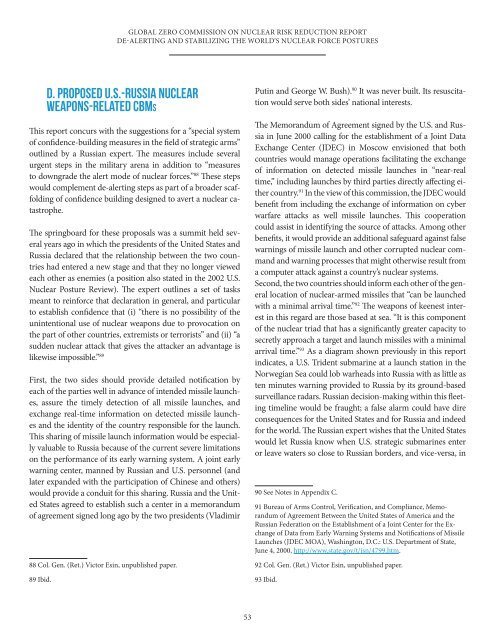global_zero_commission_on_nuclear_risk_reduction_report
global_zero_commission_on_nuclear_risk_reduction_report
global_zero_commission_on_nuclear_risk_reduction_report
You also want an ePaper? Increase the reach of your titles
YUMPU automatically turns print PDFs into web optimized ePapers that Google loves.
GLOBAL ZERO COMMISSION ON NUCLEAR RISK REDUCTION REPORTDE-ALERTING AND STABILIZING THE WORLD’S NUCLEAR FORCE POSTURESD. PROPOSED U.S.-RUSSIA NUCLEARWEAPONS-RELATED CBMSThis <strong>report</strong> c<strong>on</strong>curs with the suggesti<strong>on</strong>s for a “special systemof c<strong>on</strong>fidence-building measures in the field of strategic arms”outlined by a Russian expert. The measures include severalurgent steps in the military arena in additi<strong>on</strong> to “measuresto downgrade the alert mode of <strong>nuclear</strong> forces.” 88 These stepswould complement de-alerting steps as part of a broader scaffoldingof c<strong>on</strong>fidence building designed to avert a <strong>nuclear</strong> catastrophe.The springboard for these proposals was a summit held severalyears ago in which the presidents of the United States andRussia declared that the relati<strong>on</strong>ship between the two countrieshad entered a new stage and that they no l<strong>on</strong>ger viewedeach other as enemies (a positi<strong>on</strong> also stated in the 2002 U.S.Nuclear Posture Review). The expert outlines a set of tasksmeant to reinforce that declarati<strong>on</strong> in general, and particularto establish c<strong>on</strong>fidence that (i) “there is no possibility of theunintenti<strong>on</strong>al use of <strong>nuclear</strong> weap<strong>on</strong>s due to provocati<strong>on</strong> <strong>on</strong>the part of other countries, extremists or terrorists” and (ii) “asudden <strong>nuclear</strong> attack that gives the attacker an advantage islikewise impossible.” 89First, the two sides should provide detailed notificati<strong>on</strong> byeach of the parties well in advance of intended missile launches,assure the timely detecti<strong>on</strong> of all missile launches, andexchange real-time informati<strong>on</strong> <strong>on</strong> detected missile launchesand the identity of the country resp<strong>on</strong>sible for the launch.This sharing of missile launch informati<strong>on</strong> would be especiallyvaluable to Russia because of the current severe limitati<strong>on</strong>s<strong>on</strong> the performance of its early warning system. A joint earlywarning center, manned by Russian and U.S. pers<strong>on</strong>nel (andlater expanded with the participati<strong>on</strong> of Chinese and others)would provide a c<strong>on</strong>duit for this sharing. Russia and the UnitedStates agreed to establish such a center in a memorandumof agreement signed l<strong>on</strong>g ago by the two presidents (Vladimir88 Col. Gen. (Ret.) Victor Esin, unpublished paper.89 Ibid.Putin and George W. Bush). 90 It was never built. Its resuscitati<strong>on</strong>would serve both sides’ nati<strong>on</strong>al interests.The Memorandum of Agreement signed by the U.S. and Russiain June 2000 calling for the establishment of a Joint DataExchange Center (JDEC) in Moscow envisi<strong>on</strong>ed that bothcountries would manage operati<strong>on</strong>s facilitating the exchangeof informati<strong>on</strong> <strong>on</strong> detected missile launches in “near-realtime,” including launches by third parties directly affecting eithercountry. 91 In the view of this <str<strong>on</strong>g>commissi<strong>on</strong></str<strong>on</strong>g>, the JDEC wouldbenefit from including the exchange of informati<strong>on</strong> <strong>on</strong> cyberwarfare attacks as well missile launches. This cooperati<strong>on</strong>could assist in identifying the source of attacks. Am<strong>on</strong>g otherbenefits, it would provide an additi<strong>on</strong>al safeguard against falsewarnings of missile launch and other corrupted <strong>nuclear</strong> commandand warning processes that might otherwise result froma computer attack against a country’s <strong>nuclear</strong> systems.Sec<strong>on</strong>d, the two countries should inform each other of the generallocati<strong>on</strong> of <strong>nuclear</strong>-armed missiles that “can be launchedwith a minimal arrival time.” 92 The weap<strong>on</strong>s of keenest interestin this regard are those based at sea. “It is this comp<strong>on</strong>entof the <strong>nuclear</strong> triad that has a significantly greater capacity tosecretly approach a target and launch missiles with a minimalarrival time.” 93 As a diagram shown previously in this <strong>report</strong>indicates, a U.S. Trident submarine at a launch stati<strong>on</strong> in theNorwegian Sea could lob warheads into Russia with as little asten minutes warning provided to Russia by its ground-basedsurveillance radars. Russian decisi<strong>on</strong>-making within this fleetingtimeline would be fraught; a false alarm could have direc<strong>on</strong>sequences for the United States and for Russia and indeedfor the world. The Russian expert wishes that the United Stateswould let Russia know when U.S. strategic submarines enteror leave waters so close to Russian borders, and vice-versa, in90 See Notes in Appendix C.91 Bureau of Arms C<strong>on</strong>trol, Verificati<strong>on</strong>, and Compliance, Memorandumof Agreement Between the United States of America and theRussian Federati<strong>on</strong> <strong>on</strong> the Establishment of a Joint Center for the Exchangeof Data from Early Warning Systems and Notificati<strong>on</strong>s of MissileLaunches (JDEC MOA), Washingt<strong>on</strong>, D.C.: U.S. Department of State,June 4, 2000, http://www.state.gov/t/isn/4799.htm.92 Col. Gen. (Ret.) Victor Esin, unpublished paper.93 Ibid.53


